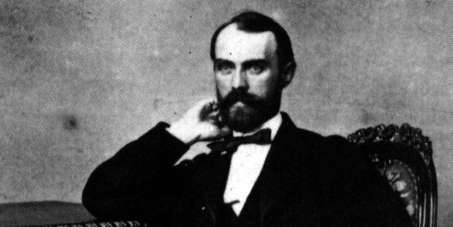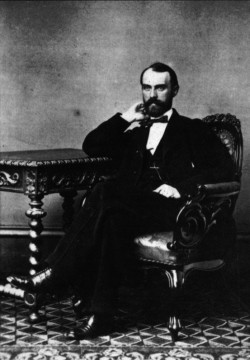Karl Collan 1864 and 1868
Karl Collan (1828–1871) was interested in music, languages, the newspaper industry and library science. He studied the new trends within these fields also in Europe and he brought influences of these trends with him to the cultural life in his home country. He earned his living as a teacher of the German language and he also worked as a journalist. Karl Collan seemed to live his best life in the 1860’s. The first part of his Swedish translation of the Kalevala was published in 1864. In 1866 he married Maria (née Pacius) and was appointed to his dream job when he became a librarian at the University of Helsinki. The second part of his Swedish translation of the Kalevala came out 1868 and a year later his daughter Maria was born.
In the early 1870’s Karl Collan died of cholera. The legacy of Collan, who was 43 years old when he died, was that it reformed and improved practices in the university library, practices that Collan had learned when visiting the British Museum. Examples of Collan’s legacy that have become essential parts of the musical culture in Finland are the songs Sylvian joululaulu, Vaasan marssi and Savolaisen laulu. Karl Collan did an enormous effort when he translated the Kalevala into Swedish.
When he worked on the Swedish translation of the 1849 Kalevala, Karl Collan may have compared his ideas to Elias Lönnrot’s own translations, the translations of the poems Kullervo and Lemminkäinen by C. G. Borg and, in particular, to M. A. Castrén’s translation of the Old Kalevala (1841). Collan decided that he would attempt to, as much as possible, use the trochaic octameter and leave out the alliterations and other textual ornamentations. He was aware of the risks with his decision:
“[This translation is done] by using the old, simple, non-rhyme poetic meter, there is a risk that it, thus, by many is regarded as too monotonous and, perhaps, not enjoyable”, Collan writes (1868, part I, XXIII) in his preface of the translation.
The translation by Karl Collan became a classic, but, among other things, this aforementioned “not enjoyable trait” was a reason that the Swede Björn Collinder decided to make a new translation of the Kalevala approximately one hundred years later.
Karl Collan: Kalevala. Helsingfors: Theodor Sederholms boktryckeri. 1864. (Read 23.2.2016.)
Esko Häkli: Collan, Karl (1828–1871). Kansallisbiografia-verkkojulkaisu. (Read 23.2.2016.)
Esko Häkli: Collan, Karl (1828–1871). Biografisk lexicon för Finland. (Read 23.2.2016.)

